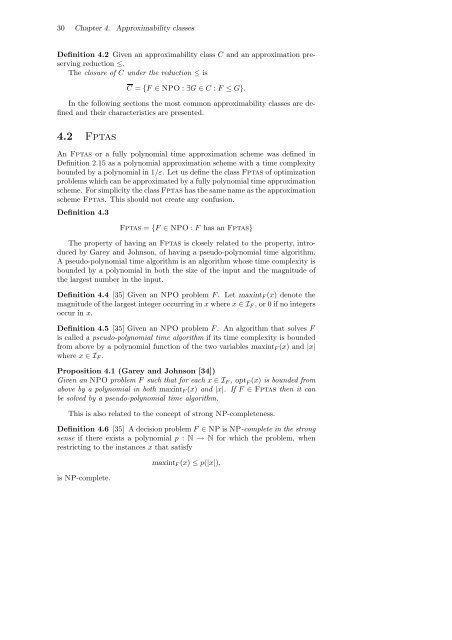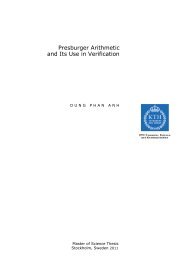On the Approximability of NP-complete Optimization Problems
On the Approximability of NP-complete Optimization Problems
On the Approximability of NP-complete Optimization Problems
Create successful ePaper yourself
Turn your PDF publications into a flip-book with our unique Google optimized e-Paper software.
30 Chapter 4. <strong>Approximability</strong> classes<br />
Definition 4.2 Given an approximability class C and an approximation preserving<br />
reduction ≤.<br />
The closure <strong>of</strong> C under <strong>the</strong> reduction ≤ is<br />
C = {F ∈ <strong>NP</strong>O : ∃G ∈ C : F ≤ G}.<br />
In <strong>the</strong> following sections <strong>the</strong> most common approximability classes are defined<br />
and <strong>the</strong>ir characteristics are presented.<br />
4.2 Fptas<br />
An Fptas or a fully polynomial time approximation scheme was defined in<br />
Definition 2.15 as a polynomial approximation scheme with a time complexity<br />
bounded by a polynomial in 1/ε. Let us define <strong>the</strong> class Fptas <strong>of</strong> optimization<br />
problems which can be approximated by a fully polynomial time approximation<br />
scheme. For simplicity <strong>the</strong> class Fptas has <strong>the</strong> same name as <strong>the</strong> approximation<br />
scheme Fptas. This should not create any confusion.<br />
Definition 4.3<br />
Fptas = {F ∈ <strong>NP</strong>O : F has an Fptas}<br />
The property <strong>of</strong> having an Fptas is closely related to <strong>the</strong> property, introduced<br />
by Garey and Johnson, <strong>of</strong> having a pseudo-polynomial time algorithm.<br />
A pseudo-polynomial time algorithm is an algorithm whose time complexity is<br />
bounded by a polynomial in both <strong>the</strong> size <strong>of</strong> <strong>the</strong> input and <strong>the</strong> magnitude <strong>of</strong><br />
<strong>the</strong> largest number in <strong>the</strong> input.<br />
Definition 4.4 [35] Given an <strong>NP</strong>O problem F . Let maxintF (x) denote<strong>the</strong><br />
magnitude <strong>of</strong> <strong>the</strong> largest integer occurring in x where x ∈IF , or 0 if no integers<br />
occur in x.<br />
Definition 4.5 [35] Given an <strong>NP</strong>O problem F . An algorithm that solves F<br />
is called a pseudo-polynomial time algorithm if its time complexity is bounded<br />
from above by a polynomial function <strong>of</strong> <strong>the</strong> two variables maxintF (x) and|x|<br />
where x ∈IF .<br />
Proposition 4.1 (Garey and Johnson [34])<br />
Given an <strong>NP</strong>O problem F such that for each x ∈IF , opt F (x) is bounded from<br />
above by a polynomial in both maxintF (x) and |x|. If F ∈ Fptas <strong>the</strong>n it can<br />
be solved by a pseudo-polynomial time algorithm.<br />
This is also related to <strong>the</strong> concept <strong>of</strong> strong <strong>NP</strong>-<strong>complete</strong>ness.<br />
Definition 4.6 [35] A decision problem F ∈ <strong>NP</strong> is <strong>NP</strong>-<strong>complete</strong> in <strong>the</strong> strong<br />
sense if <strong>the</strong>re exists a polynomial p : N → N for which <strong>the</strong> problem, when<br />
restricting to <strong>the</strong> instances x that satisfy<br />
is <strong>NP</strong>-<strong>complete</strong>.<br />
maxintF (x) ≤ p(|x|),

















